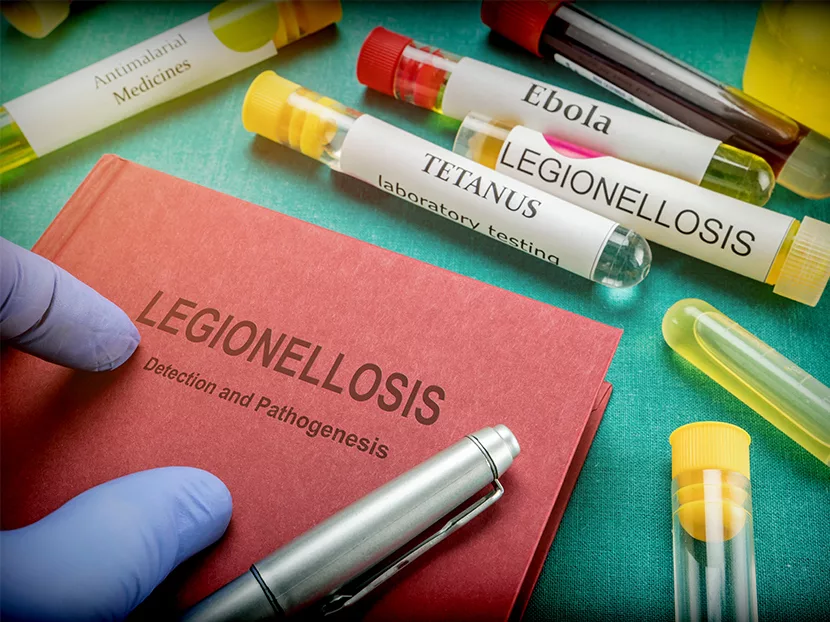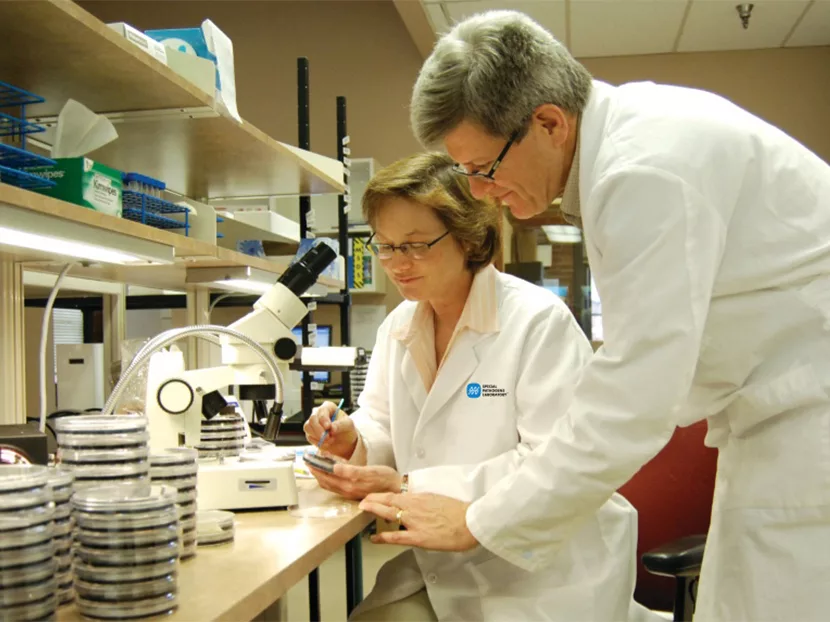I am a Legionellologist. What is that, you ask? It’s the term for an infectious disease microbiologist who has been studying Legionnaires’ disease for more than 30 years. And because I’m a Legionellologist, I have the long view of our path to prevention of Legionnaires’ disease. It may seem elusive to many and perhaps a fool’s errand. But I am a glass-half-full type of person and my mission is evidence-based, grounded in science and guided by field experience.
In 1982, the results of my first study of Legionella bacteria in hospital plumbing systems were published in the New England Journal of Medicine. It was a ground-breaking study because my colleagues and I identified the hospital hot water system as the source of the outbreak of Legionnaires’ disease at the Pittsburgh VA hospital. At the time, cooling towers had been thought to be the principal source of exposure. In the midst of an endemic, clinicians and researchers at the VA implemented a robust Legionella program that prevented cases for more than 20 years. Few can make this claim.
Now, 36 years later, we know that potable water, especially the warm-water systems of large buildings such as hospitals, is the primary source of transmission of this deadly form of bacterial pneumonia.
Among outbreaks investigated by the Centers for Disease Control and Prevention (CDC), exposure to Legionella bacteria from water distribution systems of buildings was responsible for 56 percent of the outbreaks; cooling towers caused only 22 percent of cases.
Health-care facilities are especially vulnerable. A review of 27 Legionnaires’ disease outbreaks investigated by the CDC during 2000–2014 indicated that health-care-associated Legionnaires’ disease accounted for 33 percent of the outbreaks, 57 percent of the cases and 85 percent of deaths. In addition, 85 percent of all Legionnaires’ disease outbreaks were attributed to water system exposures.
Unfortunately, Legionnaires’ disease is on the rise. The CDC found that there are about 6,000 new diagnoses of Legionnaires’ annually in the United States; rates of the disease are up a staggering 450 percent since 2002. Dr. Laura Cooley, a medical epidemiologist with the CDC, spoke at the 2017 ID week conference on the causes of the rising number of cases of Legionnaires’ disease stating that the reported cases were up by nearly 300 percent. You can view a video of her comments below.
What’s more, the incidence of reported Legionnaires’ disease cases in the U.S. tripled between 2000 and 2009, with medical costs estimated at $321 million per year. This cost in dollars and human suffering brings with it an interest in the topic of liability and even greater attention to prevention. Read more here.
Controlling Legionnaires'
According to the CDC: “Legionella grows best in building water systems that are not well-maintained, especially where levels of chlorine or other disinfectants are low and water temperatures are optimal for its growth. Legionnaires’ disease outbreaks most often occur in hotels, long-term care facilities and hospitals. The most common sources are potable water, cooling towers, hot tubs and decorative fountains.”
However, Legionnaires’ disease is not the result of a poorly maintained water distribution system. While there can be instances where a hot tub or spa, decorative fountain, or cooling tower were not properly treated nor maintained, the same cannot be said for most water distribution systems of buildings. There isn’t much to maintain within a building water distribution system — water of a quality not under a facility’s control enters the building and is distributed and circulated at a temperature usually dictated by plumbing code.
When building-associated cases of Legionnaires’ disease have occurred, much has been learned about controlling the growth and spread of Legionella bacteria in our water systems. Unfortunately, achieving control has been difficult because easy fixes such as raising hot water temperature are not permitted in most buildings of high risk such as hospitals and long-term care and nursing homes.
Health care facilities must maintain a hot water temperature that Legionella and other bacteria love — just above body temperature. Concern over scald potential of higher temperature and code restrictions prevents such facilities from increasing hot water temperatures in the range that could control Legionella — around 130 F.
Legionella bacteria enter a building from the municipal water supply — usually in numbers so low as to be undetectable. Legionella bacteria do not grow, spread and colonize all building water systems. In our experience, about half of the buildings we test for Legionella are positive. We have shown that proactively testing for Legionella and finding many outlets (>30 percent) in a hospital or building positive for Legionella (especially Legionella pneumophila, serogroup 1) can be an indicator that the risk for illness is greater.
The proportion of outlets positive is a better predictor of disease risk than the concentration (CFU/mL) of Legionella bacteria recovered. This has been demonstrated in prospective studies linking environmental positivity to disease risk. The 2016 New York State Department of Health regulations for the prevention of health-care-acquired Legionnaires’ disease in hospitals uses this metric to help health-care facilities assess risk within their water systems and when disinfection may be warranted. A minimum of 10 outlets are to be tested.
We know that this disease can be controlled and prevented. In a 2005 study, the only study of its kind, we showed significant reduction of health-care-associated Legionnaires’ disease in Western Pennsylvania (Allegheny County) hospitals by applying this approach of proactively testing the water systems of hospitals before cases occur and using supplemental disinfection to reduce Legionella. The reduction in cases was highly statistically significant.
Supplemental addition of a disinfectant to the water can control Legionella but you will not eradicate it. Control is all you need to keep this naturally occurring inhabitant of our water systems from doing harm. A variety of supplemental disinfectants are typically applied to the hot water system where Legionella can grow and amplify. The disinfectant is delivered to the outlets and controls Legionella at the point of exposure. These supplemental disinfection systems include copper-silver ionization, chlorine dioxide and monochloramine.
What about chlorine? Chlorine is an effective biocide but it has to be used at such high concentrations to be effective against Legionella (typically 2 ppm or higher), that corrosion and disinfection by-products become problems. I would not recommend it.
Cold water can have some Legionella in it; however, the amount is generally small and a fraction of what is in the warm water system. Furthermore, controlling Legionella with hot water-only application of disinfectants means you can avoid adding chemicals (and disinfection by-products) to the cold drinking water that people consume. Remember, the goal is to eliminate the disease; you cannot consistently reach and maintain zero Legionella in a complex water system.
Building on success
Can we end Legionnaires’ disease — is it even possible? Well, we have more than 30 years of results showing that looking for Legionella in the environment before cases occur and taking action to control Legionella bacteria is effective in reducing health-care-acquired Legionnaires’ disease. Let’s build on that success.
Implementation of water management plans per the industry standard ANSI/ASHRAE Standard 188-2015: Legionellosis: Risk Management for Building Water Systems is being used and promoted as the industry best practice for managing Legionella in building water systems. Government agencies such as the CDC and the Centers for Medicare & Medicaid Services (CMS) refer to the ASHRAE standard. CMS released a survey and certification memo stating that health-care facilities should develop and adhere to ASHRAE-compliant water management programs to reduce the risk for Legionella and other pathogens in their water systems.
What is the guidance from these organizations on testing for Legionella? ASHRAE and, by default CDC and CMS, leaves the decision to test for Legionella at the discretion of the facility water management team.
The CDC’s toolkit, “Developing a Water Management Program to Reduce Legionella Growth and Spread in Buildings: A Practical Guide to Implementing Industry Standards,” states that environmental testing for Legionella is useful to validate the effectiveness of control measures. Factors that might make testing for Legionella more important include:
- Having difficulty maintaining the building water systems within control limits;
- Having a prior history of Legionnaires’ disease associated with the building water systems; and
- Being a health care facility that provides inpatient services to people who are at increased risk for Legionnaires’ disease.
Each building owner must assess the risk and validate their plans to indicate control of the hazard (Legionella). Determining the risk or validating a water management plan cannot be done without testing for Legionella. Any organization that disputes this and tells people not to test their water systems as part of an effective prevention strategy is at best foolish and at worst endangering lives.
It is crucial that the building water management team understand they cannot use other measures to predict either the presence or absence of Legionella in building water systems. Not chlorine, not temperature, not cleaning faucet aerators nor counting other bacteria have been shown to assess or reduce the risk for Legionnaires’ disease reliably.
For example, it is not unusual to find high counts of total bacteria in the warm water system of a hospital or building. You may be told this is a reason to perform remediation or install supplemental disinfection. Don’t be fooled.
We and others have found high counts of total heterotrophic plate count bacteria (HPC) from different types of faucets, those with no aerator (control), with aerators and with laminar flow devices. We showed laminar flow to yield significantly higher HPC counts (CFU/mL) than the control or aerator. HPC recovery was 16,129 (SD +10,939.1), 13,558.4 (SD + 8410.45) and 24,786.9 (SD + 12544.9), respectively. However, there was no significant association with recovery of Legionella, meaning higher HPC counts did not predict Legionella positivity. This is also true for cooling towers; Legionella can be present whether HPC counts are high or low.
The CDC toolkit warns of this lack of association, stating: “Heterotrophic plate counts: A measure of the number and variety of bacteria that are common in water; a high count may indicate a high microbial load and the need for corrective action but cannot be substituted for Legionella testing.”
If we are going the end Legionnaires’ disease (my mission as a Legionellologist), we have got to do better. Here’s how:
- Test before cases occur to know if and what kind of Legionella is in your water system and to see if your water management plan is working.
- If more than 30 percent of outlets are positive, take corrective actions.
- Promote collaboration between risk managers, infection control and facility engineers.
- Diagnose and treat early to save lives. A delay of just a few days in receiving effective antibiotics such as levofloxacin or azithromycin can result in a dramatic increase in the risk of death.
- Incorporate ASHRAE Standard 188 into the International Code Council’s International Plumbing Code.
Fortunately, the state of New York also provided a roadmap. It has learned the painful lessons that deadly outbreaks bring. Both New York City and New York State regulations require testing of cooling towers and health-care facility water distribution systems for the presence of Legionella. Click here to view the New York State regulation.
Yes, ending Legionnaires’ disease is an audacious goal, but not so audacious that it can’t be achieved. This Legionellologist believes it’s possible, how about you?






